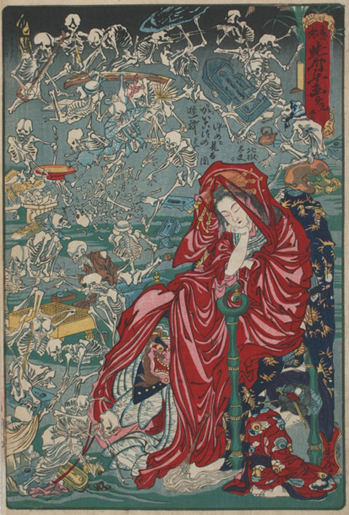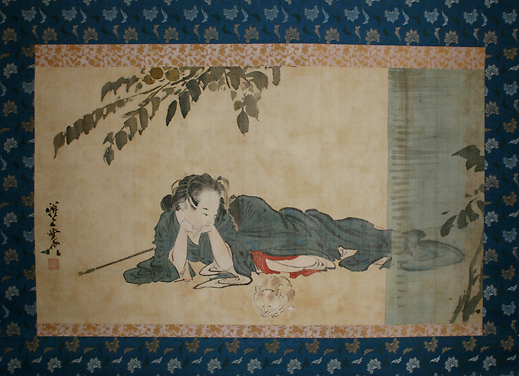 |
|
 |
Kawanabe Kyosai, Fujin Raijin
(Wind God and Thunder God)
|
|
Kawanabe Kyosai, Jigoku Dayu
(Hell Courtesan) |
Like the proverbial prophet without honor, early Meiji era artist Kawanabe Kyosai (1831-1889) until recently seemed better remembered among Western aficionados of Japanese art than among his own countrymen. A legend in his own time with a taste for the bizarre, whose training and talent sprawled across several disparate painting traditions, Kyosai defies categorization but is now gaining belated recognition as one of Japan's greatest artists.
Indicative of his renewed popularity is the fact that two museums in Kyoto held concurrent shows devoted to Kyosai this past April. The Kyoto National Museum offered a massive retrospective, particularly of his paintings in the relatively orthodox Kano style, while across town the Kyoto International Manga Museum focused on his ribald, satirical ukiyo-e sketches, a direct precursor of today's manga.
Kyosai's talent was apparent from an early age; at seven he became a pupil of the great ukiyo-e artist Kuniyoshi, but barely two years later switched to an apprenticeship in the Kano school, the official painters of the Shogunate. His fondness for grotesqueries also reared its head early on; while still a schoolboy he was drawing sketches of corpses.
Growing up in a period of social and political turmoil as the Shogunate gave way to the Meiji Restoration, Kyosai found ample fodder for his satirical impulses and became known for his impromptu sketches of political figures and events, often tossed off while downing prodigious amounts of sake. In 1870, barely two years into the Meiji "Enlightenment," he was imprisoned and flogged by the authorities for his irreverent output.
After this sobering experience Kyosai tended to restrict his parodies to more general human foibles, which he depicted in the loose caricature style of the ukiyo-e tradition; at the same time, he produced exquisite paintings of Buddhist deities on commission in the Kano style. Whatever the genre, his technique was peerless, and his output nothing short of astonishing. In one legendary episode he covered a 17-meter length of stage curtain with caricatures of famous Kabuki actors for the Shintomi Theatre in four hours -- while drunk. He was still in his prime when he died of stomach cancer at age 58. Before he died, however, he had been discovered by several Western visitors to Japan, notably the British architect Josiah Conder, who studied painting with Kyosai and wrote a book about him.
Though his training was traditional, Kyosai's outlook was decidedly modern. Much of his satire was aimed at the inevitable contradictions between Shogun-era mores and the sudden Meiji obsession with modernization and Western-style enlightenment. Some of his parodies, like a painting of the Buddhist deity Acala reading a Ministry of Education tract promoting Western customs, are obvious precursors of the works of postwar satirists like Masami Teraoka, known for his burger-munching geisha. Kyosai also had a love of the supernatural, particularly Japan's indigenous yokai -- part ghost, part demon -- often depicted in the process of enthusiastically tormenting mortal humans.
Kyosai's recent revival in Japan can be credited in part to the tireless efforts of his great-granddaughter Kawanabe Kusumi, who in 1977 converted a home in the suburbs north of Tokyo into the small but tastefully appointed Kawanabe Kyosai Memorial Museum. With only three rooms in which to display its collection of some 3,000 works by Kyosai, the museum rotates its exhibits every month or so. In any given month, however, a visitor will get to enjoy a cross-section of the unparalleled oeuvre of this one-of-a-kind genius.
 |
Kawanabe Kyosai, Yokotawaru Bijin to Neko
(Reclining Beauty and Cat) |
|
|